
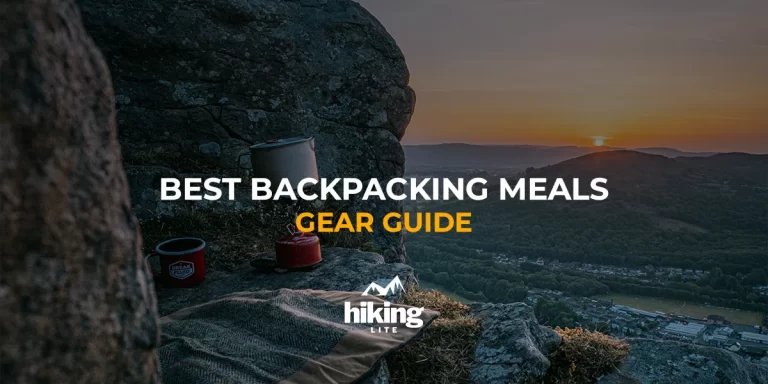
Whether you’re planning a multi-day backpacking trip through the wilderness or just looking to lighten your load for day hikes, choosing the best dehydrated backpacking meals is an important part of your preparations.
While lightweight and convenient, not all dehydrated options are created equal. In this guide, we’ll break down the top factors to consider when selecting backcountry meals, like nutritional value, weight, ease of preparation, and of course, flavor.
We’ve tested a variety of popular brands and flavors to provide our honest ratings.
Let’s dive into what really matters when it comes to enjoying tasty, sustaining fare while traveling light on the trail.
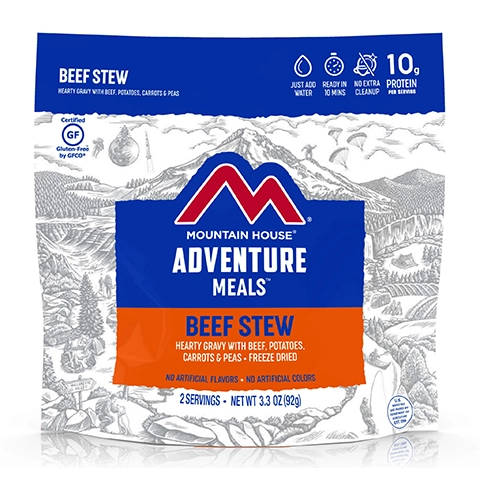
Key Specs
Weight: On average: 4.33 ounces (123 grams)
Price: $$
PROS
✅ Ultralight
✅ Wide selection
CONS
❌ Instructions can lead to a watery meal
Mountain House is a popular brand for freeze-dried camping and backpacking meals. They have many tasty and filling options for outdoor adventures.
We tested their meals, and they come in generous portions. The pouches are easy to pack in our backpacks. To prepare, we just needed to boil some water and pour it into the pouch. After letting it sit for 9-10 minutes, we had a hot and delicious meal.
The rehydrated meals had a better texture than I thought, and all the ones we tried had visible meat chunks.
Here’s a tip: Use a little less water than the instructions say. I found the meals were creamier and less watery that way. The meals have 280 to 510 calories per pouch, so they give you a substantial and protein-filled meal for your adventures.
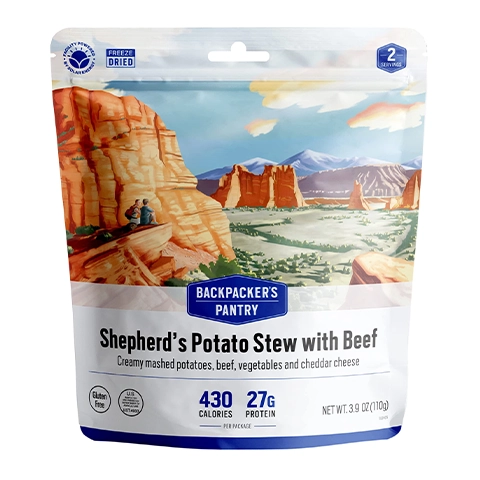
Key Specs
Weight: On average: 5 ounces (142 grams)
Price: $$$
PROS
✅ High protein options
CONS
❌ Expensive
❌ Instructions can lead to a watery meal
Backpacker’s Pantry meals provide a good choice for a change in outdoor eating. We appreciate their vegetarian options and high protein content.
While the flavor might not be as intense as some other brands like Mountain House, these meals are convenient and easy to prepare, making them ideal for backpacking.
One tip we have is to use a bit less water at first to prevent a watery outcome and extend the wait time by a couple extra minutes for the best texture.
Overall, Backpacker’s Pantry is a solid pick for those who want variety and excellent nutrition in their lightweight, yet generously portioned, outdoor meals. The vegetarian and vegan options make it easy to get protein while avoiding meat.

Key Specs
Weight: On average: 7.05 ounces (200 grams)
Price: $$$
PROS
✅ High protein options
CONS
❌ Expensive
Peak Refuel provides a tasty and top-notch choice with real meat and double the protein of many others, making it a strong option. These meals are made with premium freeze-dried ingredients, keeping their natural texture and flavor.
Although the portion size might be a bit smaller than we’d expect, the great taste, calorie content, and quality make it a worthwhile.
Additionally, Peak Refuel offers excellent breakfast choices that many people we know enjoy. With double the protein of many freeze-dried options, Peak Refuel provides a tasty and nutritious choice for outdoor adventures.
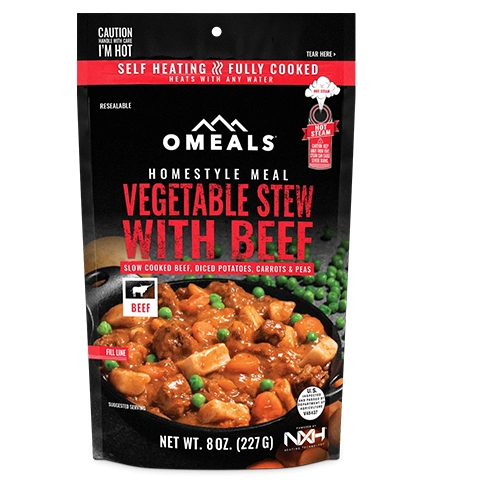
Key Specs
Weight: On average: 8 ounces (227 grams)
Price: $$
PROS
✅ No stove option
✅ Easiest to prepare
CONS
❌ Relatively expensive
❌ Not the lightest option
Omeals provides a convenient solution for warm meals outdoors with their self-heating camping food. Without the need for fuel or a stove, you can enjoy a flavorful dish within minutes.
These compact and portable meal packs are suitable for camping, hiking, and emergency food supplies. The high-quality ingredients ensure great taste and nutritional value based on what we have tried.
When using the self-heating Omeals, we noticed that while the heating process works well, adding a touch of salt can enhance the heat. However, we do keep in mind that the weight can be a bit heavy due to the included heating element.
Despite this extra weight, Omeals offers a satisfying option to diversify your outdoor meals without requiring any extra equipment.
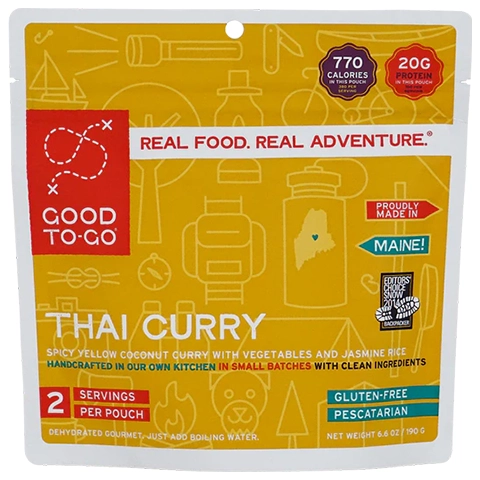
Key Specs
Weight: On average: 6.56 ounces (186 grams)
Price: $
PROS
✅ Affordable
✅ Healthier option
CONS
❌ Flavours might not suit everybody
Good-to-Go meals stand out because they use healthier ingredients and have less salt than the usual choices. It’s a bit of a two-sided deal because some sodium can help with hydration, especially on tough hikes.
What makes them even more appealing is that they’re handcrafted and dehydrated in the USA. We found the flavors were quite decent, and they offer vegetarian, vegan, and gluten-free options too.
But if we’re planning on intense and longer activities, it might be a good idea to bring along some foods or supplements with extra electrolytes for added energy.
Overall, Good-to-Go makes a healthier freeze-dried meal choice that might fit your nutrition needs in the outdoors.
Choosing the ideal pre-made dehydrated meal can elevate your outdoor adventures. These ready-to-eat options are convenient and low-maintenance, making them a favorite among backpackers.
The selection of tasty, nutritious meals has expanded over time, including gluten-free and vegan choices. When picking a meal, aim for:
After your hike, consider a meal within 30 to 45 minutes, with a 4:1 ratio of carbohydrates to protein for effective muscle refueling and repair.
Making smart choices in your pre-made backpacking meals ensures you have the energy and sustenance for successful outdoor experiences.
For an extra boost of freshness, make sure you get enough electrolytes – check out this post to find foods that are rich in them.
When selecting pre-made dehydrated meals for backpack trips, choosing options that provide balanced nutrition, convenient preparation and great taste can enhance the outdoor experience. Look for meals averaging around 500 calories to keep you fueled through days of activity while carrying a minimal pack weight. Consider quality ingredients and shorter lists for simpler meals. Evaluate preparation times of 30-45 minutes for optimal post-hike recovery. Aim for a carbohydrate to protein ratio near 4:1 for muscle refueling. With expanding varieties like gluten-free and vegan selections, choosing meals strategically sets adventurers up for success with low-maintenance sustenance on the trail.
When preparing to rehydrate meals for backpack trips or other adventures, it’s important to have an efficient process. Most dehydrated options will need boiling water added and a rehydration period. Carefully read instructions beforehand for water amounts and steeping times. Bring a small pot for heating water while traveling light. Pour the suggested amount of hot water directly into a ziplock bag containing the meal and seal. Let it rehydrate for the prescribed time before digging in. Some meals are also rehydratable by simply adding boiling water to a bowl. No matter the method, properly rehydrating meals is key for quick and easy nourishment while on the move for treks, travel or other outdoor expeditions.
Even though dehydrated foods keep better than perishables, they still have an expiration date. When made, the food has all the moisture removed and is dried out. This helps slow down spoiling for a few months. But over time, exposure to air can make nutrients break down. It can also make fats go rancid and yucky. How long it lasts depends on storage. Bags and boxes that are sealed at the factory usually last 6 to 12 months. Stuff in regular bags only makes it 3 to 6 months. To tell if it’s bad, look for changes in color, texture, or smell. It’s important to write the dates and check “best by” times. This way you avoid eating old food on trips. By storing dehydrated meals properly in a cool place, they’ll be good to eat for backpacking.